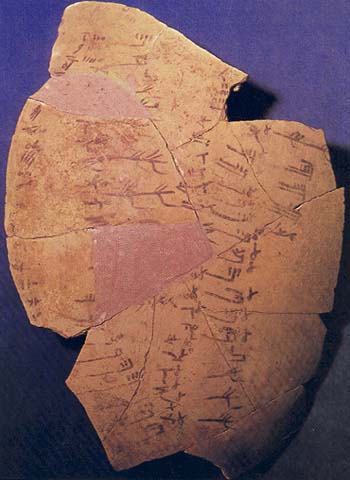Image Details

Nahshon Sneh
The signs on the ostracon are mainly numerals in Egyptian hieratic, a cursive form of Egyptian derived from hieroglyphics. As we shall see, however, this ostracon also contains two Hebrew elements, one the sign for shekel, and the other the word for thousands.
The hieratic number signs are arranged in six somewhat; regular columns identified in the drawing. The numbers increase from top to bottom, as indicated by the translations of the signs placed on the drawing of the ostracon.
The first column contains units of measurement, not yet deciphered.
The other columns are hieratic numerals. The second column, though partially missing or blurred, lists the hieratic numerals from 1 to 9, then 10 to 100 in units of tens (10, 20, 30, etc.), and from 100 to 700 in units of hundreds (100, 200, 300, etc.). The third column continues this list from 800 to 10,000 in units of thousands; the numerals 7,000 8,000 and 9,000 are missing, but can be surmised. The final figure, 10,000, is indicated by the hieratic numeral 10 and the Hebrew word alafim (meaning thousands). Some of the hieratic numerals in the second and third columns are preceded by the symbol for a unit of grain (a small “comma”). In the fourth column, the counting begins again with 1. This list breaks off in a missing fragment, but then resumes again from 1 to 40, but now preceded by the so-called “shekel” sign. The beginning of the fifth column is lost, but presumably included the numerals 50 and 60, preceded by the shekel sign. Intact are the numerals 70 to 100 in tens, and 100 to 900 in hundreds—all preceded by the shekel sign. Column five concludes with the numerals 1,000 to 4,000 in units of thousands, but without the shekel sign. The beginning of the sixth column is similarly lost, but evidently contained the numeral 5,000. The surviving portion lists the numerals 6,000 to 10,000 in thousands; 10,000 is again seen as a combination of the hieratic numeral 10 and the Hebrew alafim.
